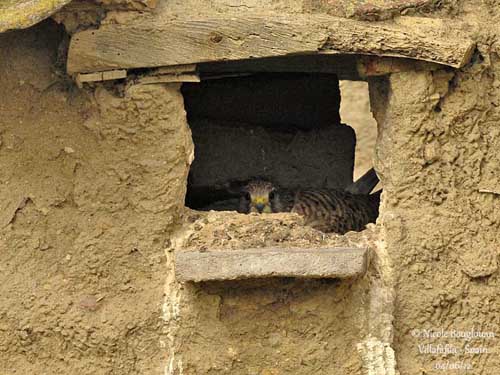
Fr: Faucon crécerellette
All : Rötelfalke
Esp : Cernícalo Primilla
Ital : Grillaio
Nd: Kleine Torenvalk
Sd: Rödfalk
Photographers:
José Luís Beamonte
Pájaros de España
Jean Marc Rabby
Des Ailes et des Plumes
Nicole Bouglouan
PHOTOGRAPHIC RAMBLE
Text by Nicole Bouglouan
Sources:
HANDBOOK OF THE BIRDS OF THE WORLD Vol 2 by Josep del Hoyo-Andrew Elliot-Jordi Sargatal - Lynx Edicions - ISBN: 8487334156
GUIDE DES RAPACES DIURNES – Europe, Afrique du Nord et Moyen-Orient de Benny Génsbol – Delachaux et Niestlé – ISBN : 2603013270
A Field Guide to the Birds of South-East Asia by Craig Robson. New Holland Publishers. ISBN: 9781780090498
BirdLife International (BirdLife International)
Animal Diversity Web (University of Michigan Museum of Zoology)
Lesser Kestrel
Falco naumanni
Falconiforme Order – Falconidae Family
BIOMETRICS:
Length: 29-32 cm
Wingspan: 58-72 cm
Weight: M: 90-172 g – F: 138-208 g
DESCRIPTION:
The Lesser Kestrel is very similar to the Common Kestrel (Falco tinnunculus), but some differences appear at close quarters.
The adult male has rufous-brown unspotted upperparts. Greater wing-coverts are bluish-grey and flight feathers are blackish. Uppertail-coverts and rectrices are blue-grey. The tail shows black subterminal band.
On the paler underparts, the buffish body is slightly spotted black, as the underwing-coverts. The blue-grey tail has also dark subterminal band on the underside, with central pair of rectrices protruding slightly.
The head is grey, usually without markings or moustache. Chin and throat are whitish.

The adult female has darker brown upperparts with black bands or spots on mantle, wing-coverts and tail. She lacks the bluish-grey areas.
On the underparts, the dark markings are heavier than in male, especially on body and underwing-coverts. The flight feathers are barred black.
Both sexes have greyish-black bill and yellow cere. The eyes are dark brown. Legs and feet are yellow with whitish claws, whereas the Common Kestrel has black ones.

The juvenile resembles female but it has paler plumage overall.
VOICE: SOUNDS BY XENO-CANTO
The Lesser Kestrel gives raucous “tche tche”, also series of harsh notes “gji gji” or “vri vri”. We can also hear a rapid “kikikik”.
These birds of prey are often very noisy when they occur in groups. On their wintering grounds, they are very noisy close to the nightime roosts.

HABITAT:
The Lesser Kestrel frequents dry, warm, semi-desert areas and steppes with scattered vegetation, pastures and cultivated fields. It may occur on monuments and old buildings in urban areas.
This species is usually found in flat or undulating lowlands, but it often breeds at 1500 metres of elevation in Asia.
It frequents the same type of habitats in winter and during migrations. They gather in large numbers at communal roosts, in old constructions or trees.
RANGE:
The Lesser Kestrel breeds in SW Europe and N Africa, E through E Europe, Asia Minor and Iran to Mongolia and N China.
This species winters in Africa, south of the Sahara, and irregularly in some parts of S Asia.

BEHAVIOUR:
The Lesser Kestrel feeds primarily on insects, both aerial and terrestrial, such as orthoptera and other invertebrates. But is also takes some small vertebrates such as lizards, rodents, birds and their chicks.
When hunting, it flies low or hovers. Once the prey is detected, it drops slowly and dives onto it from less than one metre height.

The flying insects are caught in flight with the claws and eaten while flying. But it also may hunt from perch, or even by walking on the ground.
The Lesser Kestrel hunts in groups too, especially on the wintering grounds in Africa when they gather in large numbers to follow swarming insects. The preys disturbed by fires or tractors are easily caught.

The Lesser Kestrel starts to display as soon as the female has arrived at breeding grounds. The male which arrives first selects a suitable nest-site prior to display.
These displays are mainly aerial. The male circles above the female and feigns an attack by diving onto her on the ground. It also performs flapping flight interspersed with glides, while calling loudly. Both mates fly together too, close to each other. They are colonial breeders.

This migratory species migrates to Africa, south of the Sahara, but also to some other regions such as NW Africa, S Europe and S Asia. They perform nomadic movements in winter according to the local concentrations of insects.
The Lesser Kestrel is known to chase larger raptors such as Eurasian Buzzards.

FLIGHT:
The Lesser Kestrel, as other Falconidae species, flies very well and fast, often with noisy wingbeats but slower, deeper and softer than the Common Kestrel. It also hovers, but less persistently in one place.

REPRODUCTION:
The laying occurs from mid-April to May.
The Lesser Kestrel breeds in colonies, usually in groups of 20-25 pairs, but sometimes much more. It nests in cavities in old buildings, houses, walls and ruins, both in town and countryside. Natural sites such as rock faces and quarries may be used for nesting too.


The female lays 3-6 whitish to greyish eggs heavily spotted reddish or yellowish. Both adults, but mainly the female, incubate during 26-28 days. The chicks are covered with white down at hatching. They are fed by both parents and fledge 36 days later. They still depend on parents for one week more. They are sexually mature the first year.
DIET:
The Lesser Kestrel feeds primarily on large insects such as grasshoppers, locusts, mole-crickets and large beetles. They also take small vertebrates such as lizards, rodents, birds and their nestlings.

PROTECTION / THREATS / STATUS:
The Lesser Kestrel is threatened by the use of pesticides involving reduction of preys, poisoning, demolition of old buildings used as nest-sites and loss of the habitat due to agriculture intensification.
However, several protection measures, artificial nests and even reintroduction in some areas have involved stabilisation or increase of local populations after several declines throughout the range.
The species is not currently threatened.
